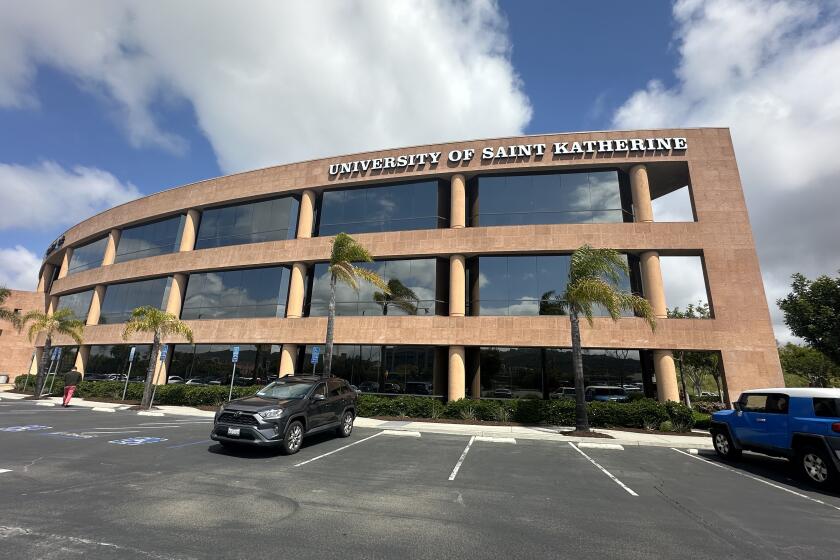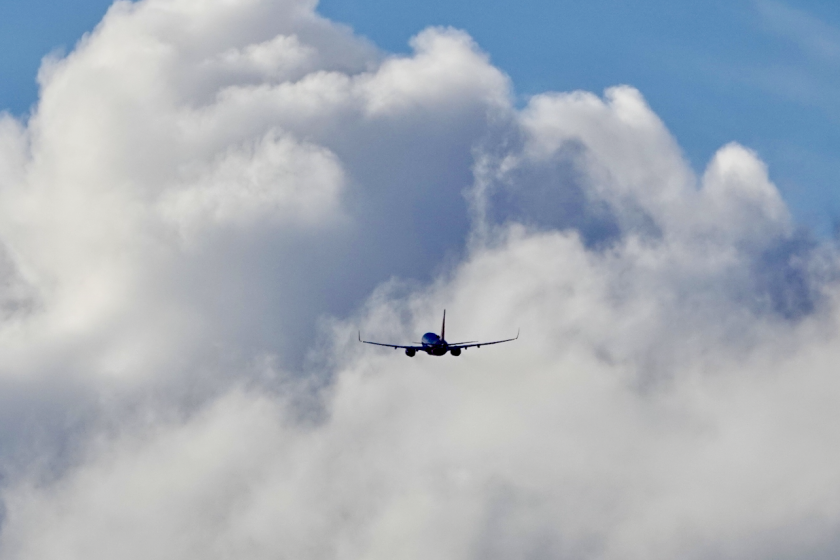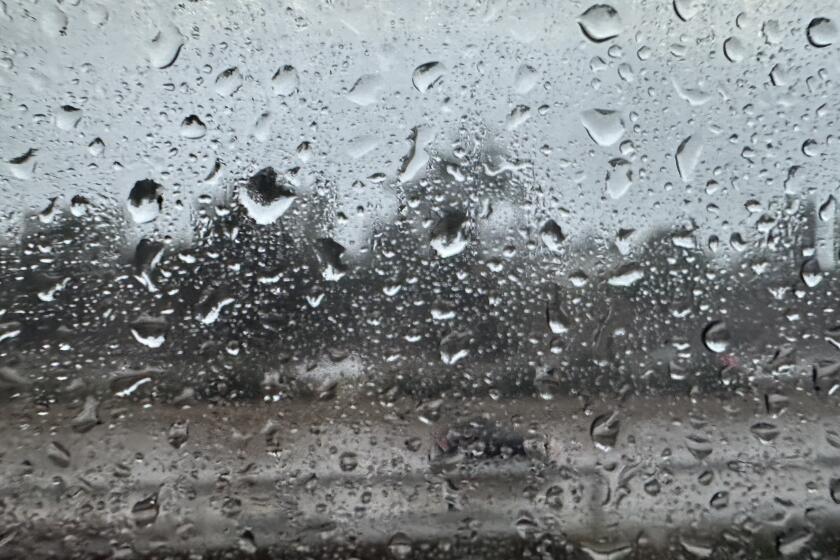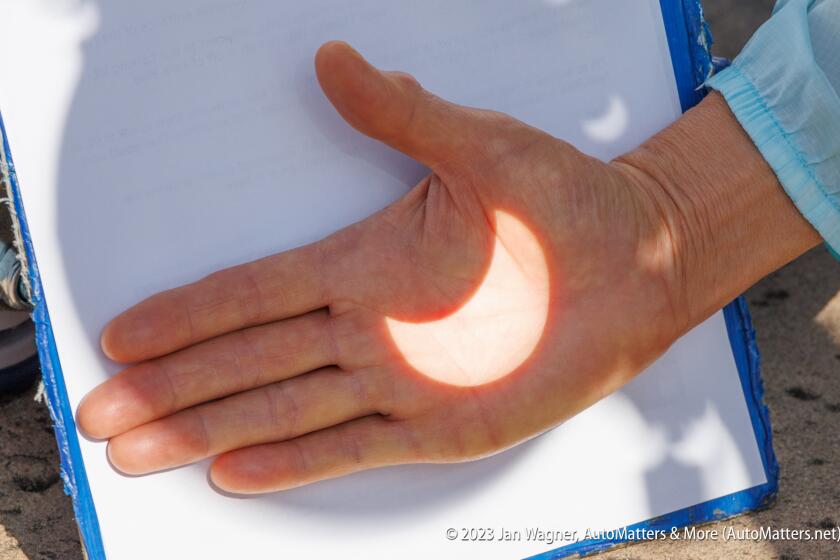Widespread flooding from rare, explosive rain event prompts dozens of rescues, destroys homes, snarls travel
Powerful floods hit southeastern San Diego neighborhoods particularly hard, forcing people onto their roofs and damaging scores of homes
A huge pool of Pacific moisture unleashed explosive rain on San Diego County Monday, flooding neighborhoods from the South Bay to Oceanside, turning roadways into rivers, prompting dozens of rescues and knocking out power to thousands.
Residents in southeastern San Diego climbed onto their roofs as rising waters swept into their homes — flooding so powerful it lifted cars and dropped them on top of other cars. Fire crews used ladders as bridges, stretching them across flooded areas to reach trapped residents. At Balboa Elementary School, water as deep as 3 feet outside prompted fire crews to move the students and teachers up to the second floor.
This is free for all readers.
As a public service, The San Diego Union-Tribune is making its storm and flood coverage free for all readers. To support our work and enjoy full access to all our journalism, please consider subscribing. For the latest news as it breaks, get our free email news alerts.
Michael Rios woke up Monday morning to water pouring into his apartment on National Avenue. With the water level 3 feet deep, he grabbed his Chihuahua, Maxey.
“I jumped out my living room window,” Rios said. “I heard my neighbor yelling that he couldn’t get out and he was trapped — so we had to break through his window to get him out.”
Once free, the pair helped a woman with a baby, and they all rushed to the second floor. “The cars and a dumpster looked like they were flowing down the street,” Rios recalled Monday night, a blanket around his shoulders, at the Red Cross shelter at Lincoln High School. “It was like a river.”
The deluge “really caused a lot of havoc,” San Diego Assistant Fire Chief David Gerboth said. Citywide, he said, there were well over 100 people rescued Monday. No deaths were reported.
“There were people stuck in cars in moving water, people stuck in the river, people stuck in homes that were flooded,” he said. “It’s been well over 10 years since we had an event that would compare.”
Forecasters had been expecting significant rain — but nothing like what San Diego County ultimately received.
During a three-hour period starting at 9 a.m., 3 inches of rain fell in National City, while 2 inches fell at San Diego International Airport, the National Weather Service said. The rain cells also appeared to contain lightning, leading forecasters to advise the airport to temporarily stop fueling aircraft during one of the busiest periods of the day.
“We almost never get rainfall that intense during a short period like that,” said Ivory Small, a weather service forecaster with more than 40 years of experience.
They thought the core of the system would curl into northern Baja California. Computer models didn’t give clear, advance noticed that it would instead collide with the 21-mile-long sliver of San Clemente Island, widely used for military exercises. The system also came straight in from the west, rather than taking a less direct path.
The collision basically tore open the plumes of moisture, causing a deluge — upwards of 1 inch of rain per hour in parts of southern San Diego County, overwhelming drainage systems.

Preliminary figures also showed that the airport got 2.70 inches of rain between midnight and 4 p.m. — the most that’s ever fallen on a January day in San Diego, a record dating back to 1850. It was also the fifth wettest day ever recorded in the city.
The deluge wiped out a 2.5-inch rainfall deficit in San Diego, and greatly tamped down the threat of wildfires. But it caused plenty of damage and prompted San Diego Mayor Todd Gloria to declare a local emergency.
Gloria said it was the first step toward receiving federal and state money to help rebuild damaged infrastructure and provide services. More than 100 homes in southeastern San Diego had been damaged or destroyed, he said.
In San Diego’s Southcrest neighborhood, crews also used boats and rescue boards to get scores of people from flooded homes on Beta Street and surrounding streets, fire officials said. Some waited on roofs to be rescued, as fast water swept up cars, dumping them onto other vehicles.
And rescue crews plucked about 45 stranded people from swollen rivers and soaked sites in the Tijuana River Valley and Mission Valley, Gerboth said.
“When you think about it, how heavy a car is, people don’t stand a chance in that,” Gerboth said. “I was surprised that the water had been so high and moved so swiftly.”
Monday’s storm came in the form of towering sheets of rain that fell fairly uniformly from Oceanside to the U.S.-Mexico border, instead of in just a handful of spots, which is more common. Soon, water began to pool on the surface of freeways, making driving perilous. And the winds began to bend trees. Imperial Beach got hit by a 48 mph gust.
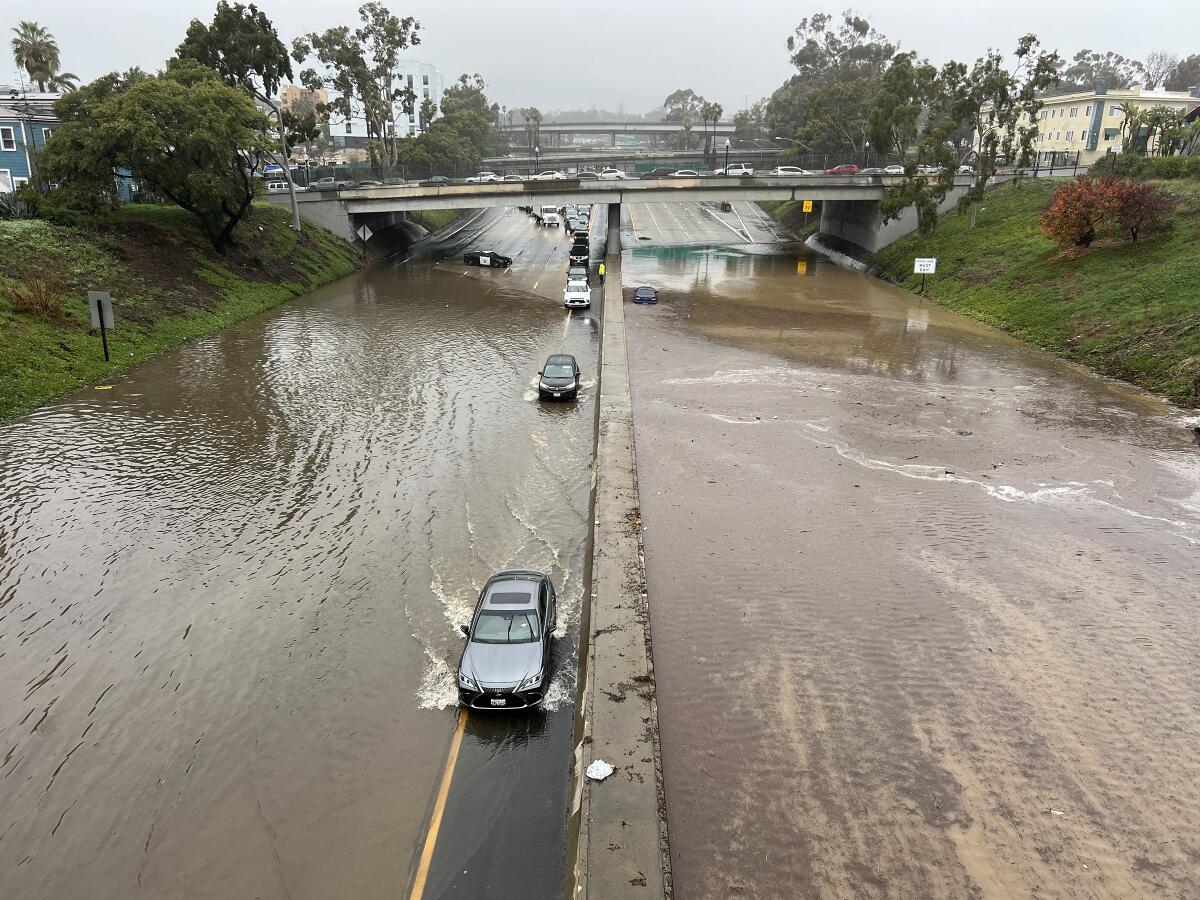
Those who dared brave the freeways were slowed not just by rain but by flooding or crashes, including a jack-knifed big rig around noon on northound Interstate 15 at Interstate 8. At points throughout the day, flooding shut a stretch of state Route 78 in Oceanside — where the water was waist-high — as well Interstate 5 in downtown San Diego and state Routes 94 and 15 in southeastern San Diego.
It also halted trolley service in downtown San Diego and in East County and caused damage to all three lines, prompting delays even where trains were running. At times, rain blew sideways through car doors, creating puddles on the seats.
Homeless residents were hit especially hard.
Flooding forced evacuations at two sites, including Alpha Project’s tent shelter downtown, where water rose chest-high in some places. Officials said it wasn’t clear if the structure, at 16th Street and Newton Avenue, was even salvageable.
Hundreds of people were moved to facilities at Balboa Park. The city’s first designated camping area was also cleared.
By early afternoon, San Diego Gas & Electric listed more than 15,000 customers without electricity on the company’s outage map, mostly in southeastern San Diego. Many people had lights back on by nightfall.
The storm prompted early Monday dismissals and Tuesday closures at schools around the county.
The La Mesa-Spring Valley Elementary School District will close all of its schools Tuesday to assess and address damage, after six campuses — primarily in Spring Valley — were flooded so heavily that entire classrooms got soaked, said Superintendent David Feliciano. The district planned to reopen schools Wednesday.
And in rural East County, rain flooded classrooms and eroded hillsides at Jamul-Dulzura schools, which sent students home early Monday and hoped to reopen Tuesday. In her more than 25 years in the district, it was the first time Superintendent Liz Bystedt could remember the district closing a school due to a downpour.
In Tijuana, schools canceled classes, as Mexican authorities urged residents to not leave home unless necessary. Tijuana firefighters evacuated 140 people, including teachers and students, from two schools in the Otay Centenario area due to flooding, city officials said.
Emergency crews responded to at least 40 rain-related incidents, including two people rescued from inside their vehicles, nine vehicles stuck in water and four landslides. Power outages were also reported in Playas de Tijuana.
San Diego fire stations were fully staffed, administrators were assigned to work in the field, and rescue teams normally assigned to the beach and bay were sent to swift water scenes far from their usual shoreline.
The rain was also a challenge for San Diego State University faculty who began a week-long strike, along with their counterparts at all 23 California State University campuses, in an effort to pressure system executives to award them significantly higher wages.
Here is a sample of how much rain had fallen over a three-day period ending at 3 p.m. Monday:
Otay Mountain, 4.51 inches; Point Loma, 4.49 inches; National City, 4.21 inches; Palomar Mountain, 4.01 inches; La Mesa, 3.89 inches; Fallbrook, 3.40 inches; Dulzura Summit, 3.38 inches, San Diego International Airport, 3.29 inches; Lake Cuyamaca, 3.23 inches; Campo, 3.20 inches; Carlsbad Airport, 3.17 inches; Bonsall, 3.09 inches; Santee, 3.05 inches.
Encinitas, 2.93 inches; Fashion Valley, 2.88 inches; Volcan Mountain, 2.81 inches; Skyline, 2.77 inches; Lake Henshaw, 2.74 inches; Oceanside, 2.69 inches; Mount Laguna, 2.62 inches; Kearny Mesa, 2.59 inches; Montgomery Field, 2.58 inches; Vista, 2.55 inches; San Onofre, 2.52 inches; Mount Laguna, 2.51 inches; Brown Field; 2.49 inches; Lake Wohlford, 2.45 inches; Miramar Lake, 2.44 inches; Pine Valley, 2.44 inches; Alpine, 2.39 inches.
Julian, 2.33 inches; San Marcos, 2.16 inches; Rancho Bernardo, 2.15 inches; Ramona Airport, 2.12 inches; Santa Ysabel, 2.07 inches; Poway, 1.99 inches; San Diego Country Estates, 1.82 inches; Borrego Springs, 0.98 inches.
Staff writers Kristen Taketa, Blake Nelson, Alexandra Mendoza and Caleb Lunetta contributed reporting.
Updates
4:27 p.m. Jan. 22, 2024: Updated with new rainfall figures.
11:05 a.m. Jan. 22, 2024: Updated with road closures and transit disruptions.
10:38 a.m. Jan. 22, 2024: New rainfall figures.
9:43 a.m. Jan. 22, 2024: Updated with warnings of possible flash flooding.
7:20 a.m. Jan. 22, 2024: New rainfall information added.
The latest news, as soon as it breaks.
Get our email alerts straight to your inbox.
You may occasionally receive promotional content from the San Diego Union-Tribune.







